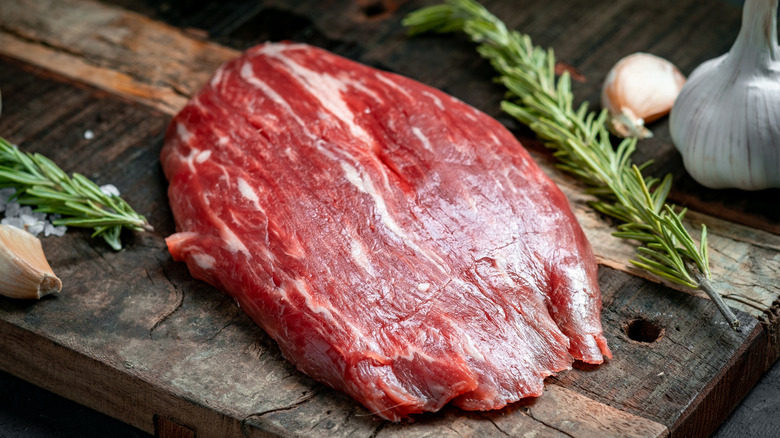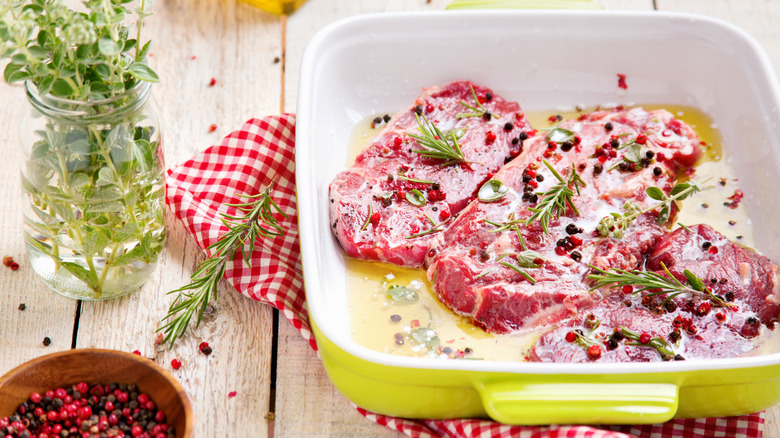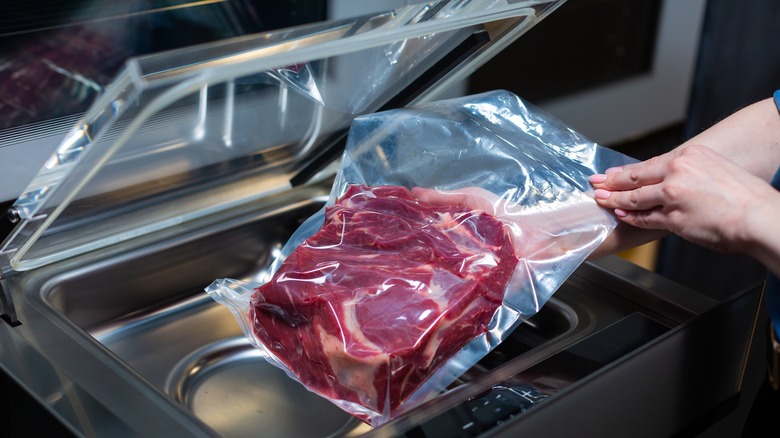The Leanest Cuts Of Steak & What To Do With Them
Lean steaks can be tricky to work with. Fat is what adds flavor to steak, so a leaner cut won't always be easy to grill (hence why so many people rave about a steak with good marbling — streaks of fat — through it). But slow-cooking methods like stewing are also less than ideal for lean meat, resulting in tough meat — save that for tough, fatty cuts.
There are options, but first, let's identify some of the leanest steak cuts out there. Top sirloin (from between the ribs and rump of a cow) is a major one. Other fairly common lean options also tend to come from the cow's rear, like top round steak and bottom round steak. Then there's eye of round steak, hailing from a cow's rump, and flank steak, noted for being both lean and full of beefy flavor. Lastly, there's the sirloin tip side steak, which comes from the legs — an area that moves a lot, so it's light on fat but can be tougher. (This isn't an exhaustive list — there are others, but these are common ones you'll find.)
If you're unsure whether you're looking at lean beef, it's worth knowing that the USDA has official definitions for both lean and ultra lean beef. "Lean" means that for 100 grams of beef, there are no more than 10 grams of fat (4.5 of which can be saturated), while "ultra lean" beef has no more than 5 grams of fat (including a maximum of 2 grams of saturated fat) per 100 grams.
If in doubt, make a marinade
It's important to clear up one misconception: You can still grill or sear lean cuts and get a juicy, tasty steak at the end of it. One way to do this is to marinate the steak beforehand. This has two major effects on the steak: First, the acid in a marinade (such as vinegar or citrus juice) softens and tenderizes meat, and it's the lean cuts that tend to have this issue of being tougher and less tender. Second, the fat or oil in a marinade adds in some of that juiciness that you'd get "naturally" in a marbled steak (although obviously, if you're eating lean steak for health reasons, the extra fat may not be ideal) and helps prevent them from drying out. Ideally, six hours to one day of marinating will work better than just a few minutes — then you can cook your lean steak on a grill or sear it in a pan.
Marinade or not, there are a few tips for cooking leaner cuts in high-heat settings like grills and frying pans. You may want to add cooking oil to compensate for the low fat, and it's better to keep it rare to medium-rare: Any longer and you're risking a dry hunk of beef. Use a meat thermometer if you're unsure. Leave it to sit for a few minutes after — if you cut it immediately, you'll lose those precious juices, too. For maximal tenderness, cut it against the grain.
Other options for your lean steak
Beyond marinating your lean steak, stir-frying is one option, although it's best with cuts that are both lean and on the tender side — sirloin and flank are good bets. The fast, high-heat cooking means they won't have time to dry out.
If you're really set on a grill or sear type of cooking method, consider reverse searing your lean steak. Here, you'll put the steak in the oven at a relatively low temperature (say 225 degrees Fahrenheit) and effectively roast it up to your desired level of doneness (again, a meat thermometer helps) — this takes 20 to 40 minutes, depending on your preference. Then you'll quickly sear it in the pan for that caramelized exterior. It basically works like a quick dry-aging process that tenderizes those tougher, lean cuts. Be sure to work with a thicker steak (1.5 inches at least): Thin cuts just get overcooked with this method.
Finally, cooking lean steaks sous-vide is a great option, as the very precise temperature settings involved in this method allow you to get the steak just right, without the risk of drying it out — a particular concern with lean cuts. That said, the cooking process is slow and it requires either specialty equipment or a potentially cumbersome DIY workaround, so it's perhaps not ideal for your average home cook.


